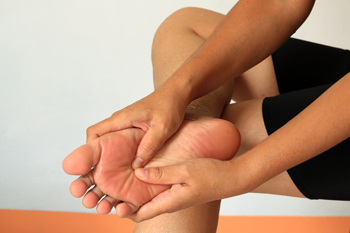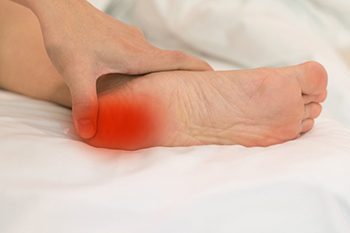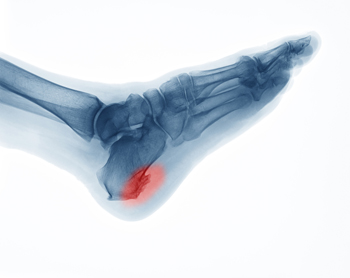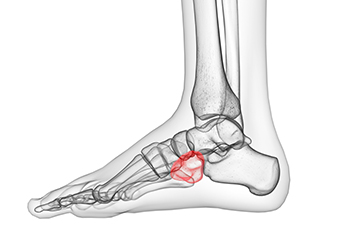
Sometimes your foot “goes to sleep” as the result of sitting awkwardly or wearing tight shoes. This is a temporary condition and in most cases, it resolves itself easily. Other causes of numbness in the feet and toes can be problematic as well as dangerous to your health. It can often be traced to a nerve damage that causes the feet to stop receiving transmissions from the brain, also known as peripheral neuropathy. Another common cause is damage to the circulatory system. Blood vessels become constricted and cannot supply the proper amount of blood to the area, causing peripheral artery disease (PAD). Diabetes, systemic diseases, vitamin deficiency, and alcoholism also can contribute to this condition. Physical conditions, including a herniated disc and spinal stenosis, can lead to numbness in one or both feet. Deep vein thrombosis (blood clots), extreme cold, atherosclerosis (a thickening of arterial walls), and Raynaud’s disease may cause numbness in the lower extremities. Caution is the byword when numbness, tingling and burning sensations in the feet and toes occur or won’t subside. Please consult a podiatrist as soon as possible for a diagnosis and appropriate treatment measures.
Neuropathy
Neuropathy can be a potentially serious condition, especially if it is left undiagnosed. If you have any concerns that you may be experiencing nerve loss in your feet, consult with Bruce Smit, DPM from Frankfort Foot & Ankle Clinic. Our doctor will assess your condition and provide you with quality foot and ankle treatment for neuropathy.
What Is Neuropathy?
Neuropathy is a condition that leads to damage to the nerves in the body. Peripheral neuropathy, or neuropathy that affects your peripheral nervous system, usually occurs in the feet. Neuropathy can be triggered by a number of different causes. Such causes include diabetes, infections, cancers, disorders, and toxic substances.
Symptoms of Neuropathy Include:
Those with diabetes are at serious risk due to being unable to feel an ulcer on their feet. Diabetics usually also suffer from poor blood circulation. This can lead to the wound not healing, infections occurring, and the limb may have to be amputated.
Treatment
To treat neuropathy in the foot, podiatrists will first diagnose the cause of the neuropathy. Figuring out the underlying cause of the neuropathy will allow the podiatrist to prescribe the best treatment, whether it be caused by diabetes, toxic substance exposure, infection, etc. If the nerve has not died, then it’s possible that sensation may be able to return to the foot.
Pain medication may be issued for pain. Electrical nerve stimulation can be used to stimulate nerves. If the neuropathy is caused from pressure on the nerves, then surgery may be necessary.
If you have any questions, please feel free to contact our office located in Frankfort, IL . We offer the newest diagnostic and treatment technologies for all your foot care needs.

An ankle sprain, a common sports injury, is an injury to the ligaments or bands of tissue that connect the bones, and that help keep the ankle stable. Usually, there is a sudden twist of the foot, and the ankle rolls in and down. There may be an audible snap or crack and sudden pain when the ankle is sprained. Swelling and bruising can develop soon after and it may be difficult to walk. Athletes that do sports requiring quick changes of direction, such as in football or tennis, are more prone to ankle sprains. If an athlete has sustained a prior ankle sprain, they are at higher risk for another one. Those who do not give the ankle sufficient time to heal after a sprain are also at higher risk of re-injuring their ankle. Usually, rest, ice, compression, and elevation will alleviate the discomfort of a sprained ankle. Giving the ankle a chance to heal before putting weight on it is recommended. Simple stretching and strengthening exercises can be done to regain motion as the ankle heals. These exercises will also help to prevent re-injury. If you are an athlete who has sustained an ankle injury it is important to see a podiatrist to make sure it is not broken and for specific recommendations for treatment.
Although ankle sprains are common, they aren’t always minor injuries. If you need your ankle injury looked at, contact Bruce Smit, DPM from Frankfort Foot & Ankle Clinic. Our doctor can provide the care you need to keep you pain-free and on your feet.
How Does an Ankle Sprain Occur?
Ankle sprains are the result of a tear in the ligaments within the ankle. These injuries may happen when you make a rapid shifting movement while your foot is planted. A less common way to sprain your ankle is when your ankle rolls inward while your foot turns outward.
What Are the Symptoms?
Preventing a Sprain
Treatment of a Sprain
In many cases, the RICE method (Rest, Ice, Compression, and Elevate) is used to treat ankle sprains. However, you should see a podiatrist to see which treatment option would work best with your injury. In severe cases, surgery may be required.
It is important to ask your doctor about rehab options after you receive treatment for your injury. Stretching, strength training, and balance exercises may help the ankle heal while also preventing further injury.
If you have any questions, please feel free to contact our office located in Frankfort, IL . We offer the newest diagnostic and treatment technologies for all your foot care needs.

Ankle pain may be caused by any number of factors including arthritis in the joints, tears in ankle ligaments, swollen/scar tissue, and bone or cartilage injuries. An ankle arthroscopy can help podiatrists diagnose and repair many issues that cause ankle pain. An arthroscope is a tiny camera that a podiatrist can insert through a small incision in the skin to capture real-time video inside your ankle. The video is displayed on a large video monitor that the podiatrist looks at to help make an accurate diagnosis of ankle pain. The podiatrist can also use this video to guide them as they use tiny instruments, which are inserted through other small incisions, to treat/repair the condition causing the ankle pain. This minimally invasive procedure is known as arthroscopic surgery. It requires much smaller incisions than open surgery with less pain and bleeding, a lowered risk of infection, and shorter recovery times. Consult with your podiatrist to see if ankle arthroscopy is appropriate for you.
Ankle pain can have many different causes and the pain may potentially be serious. If you have ankle pain, consult with Bruce Smit, DPM from Frankfort Foot & Ankle Clinic. Our doctor will assess your condition and provide you with quality foot and ankle treatment.
Ankle pain is any condition that causes pain in the ankle. Due to the fact that the ankle consists of tendons, muscles, bones, and ligaments, ankle pain can come from a number of different conditions.
Causes
The most common causes of ankle pain include:
Symptoms
Symptoms of ankle injury vary based upon the condition. Pain may include general pain and discomfort, swelling, aching, redness, bruising, burning or stabbing sensations, and/or loss of sensation.
Diagnosis
Due to the wide variety of potential causes of ankle pain, podiatrists will utilize a number of different methods to properly diagnose ankle pain. This can include asking for personal and family medical histories and of any recent injuries. Further diagnosis may include sensation tests, a physical examination, and potentially x-rays or other imaging tests.
Treatment
Just as the range of causes varies widely, so do treatments. Some more common treatments are rest, ice packs, keeping pressure off the foot, orthotics and braces, medication for inflammation and pain, and surgery.
If you have any questions, please feel free to contact our office located in Frankfort, IL . We offer the newest diagnostic and treatment technologies for all your foot care needs.

Heel pain can be caused by a variety of factors, including biomechanical issues, injuries, arthritis, and more. By far, the most common form of heel pain is plantar fasciitis, a painful inflammation of the plantar fascia tissue on the bottom of the foot that connects the heel bone with the toes. Heel spurs, which often occur concurrently with plantar fasciitis, are actually bone growths that build up on the heel bone where the plantar fascia attaches to it as a result of long-term stress. Sever’s disease occurs in growing children. It is an inflammation in the growth plate of their heel that occurs from repetitive stress to the area from physical activity or overuse. Haglund’s deformity, also known as a pump bump, occurs when the bony section at the back of the heel rubs against shoes and causes the soft tissue to become irritated and form a bump where the heel attaches to the Achilles tendon. Nerve compression can also cause heel pain, numbness, and tingling. It is sometimes associated with an ankle sprain and is known as heel neuritis. There is a fluid-filled bursa sac at the back of the heel which can become irritated and swollen from improperly fitted footwear. This condition is known as bursitis. A podiatrist can diagnose your particular heel pain after reviewing your medical history, examining you, and running diagnostic tests. Call a podiatrist today to begin to get relief from your heel pain today.
Many people suffer from bouts of heel pain. For more information, contact Bruce Smit, DPM of Frankfort Foot & Ankle Clinic. Our doctor can provide the care you need to keep you pain-free and on your feet.
Causes of Heel Pain
Heel pain is often associated with plantar fasciitis. The plantar fascia is a band of tissues that extends along the bottom of the foot. A rip or tear in this ligament can cause inflammation of the tissue.
Achilles tendonitis is another cause of heel pain. Inflammation of the Achilles tendon will cause pain from fractures and muscle tearing. Lack of flexibility is also another symptom.
Heel spurs are another cause of pain. When the tissues of the plantar fascia undergo a great deal of stress, it can lead to ligament separation from the heel bone, causing heel spurs.
Why Might Heel Pain Occur?
Treatments
Heel pain should be treated as soon as possible for immediate results. Keeping your feet in a stress-free environment will help. If you suffer from Achilles tendonitis or plantar fasciitis, applying ice will reduce the swelling. Stretching before an exercise like running will help the muscles. Using all these tips will help make heel pain a condition of the past.
If you have any questions please contact our office located in Frankfort, IL . We offer the newest diagnostic and treatment technologies for all your foot and ankle needs.

A bony growth that forms on the back of the heel bone is known as a heel spur. It can gradually produce severe pain and discomfort, and it may become difficult to walk. A heel spur can develop for several reasons, including wearing shoes that do not fit correctly, exercising on hard surfaces, or standing for long periods. A common symptom that many people experience is a sharp pain in the bottom of the heel, and this may diminish while walking. After a proper diagnosis is performed, correct treatment can begin. It may be beneficial to practice specific stretches that can help to ease the pain of a heel spur. An effective stretch consists of standing on a step and lowering the heel until a gentle pull is felt. Some patients find it can help to wear custom-made orthotics that can control the excess motion that affects the bottom of the foot. Additionally, orthotics can help take the pressure off of a heel spur. If you are affected by this painful foot condition, please consult with a podiatrist who can determine what the best form of treatment is for you.
Heel spurs can be incredibly painful and sometimes may make you unable to participate in physical activities. To get medical care for your heel spurs, contact Bruce Smit, DPM from Frankfort Foot & Ankle Clinic. Our doctor will do everything possible to treat your condition.
Heels Spurs
Heel spurs are formed by calcium deposits on the back of the foot where the heel is. This can also be caused by small fragments of bone breaking off one section of the foot, attaching onto the back of the foot. Heel spurs can also be bone growth on the back of the foot and may grow in the direction of the arch of the foot.
Older individuals usually suffer from heel spurs and pain sometimes intensifies with age. One of the main condition's spurs are related to is plantar fasciitis.
Pain
The pain associated with spurs is often because of weight placed on the feet. When someone is walking, their entire weight is concentrated on the feet. Bone spurs then have the tendency to affect other bones and tissues around the foot. As the pain continues, the feet will become tender and sensitive over time.
Treatments
There are many ways to treat heel spurs. If one is suffering from heel spurs in conjunction with pain, there are several methods for healing. Medication, surgery, and herbal care are some options.
If you have any questions feel free to contact our office located in Frankfort, IL . We offer the latest in diagnostic and treatment technology to meet your needs.

When it comes to finding the right walking shoe, you want to start by being properly fitted. Stores that specialize in athletic shoes will most likely have professional staff on hand to properly measure your feet and work with you as you are trying shoes on to ensure a proper fit. Make sure you try shoes on wearing the same socks that you will wear once you start using the shoes. Make sure the shoes feel great in the store, and do not assume that they will feel better once you “break them in” at home. Do not buy any shoe that has areas that rub against your feet. A podiatrist can also measure your feet and offer professional advice on the type of running shoe that is most appropriate for your particular feet. They can also create custom orthotics to address any gait abnormalities or structural issues your feet may have.
Getting the right shoe size is an important part of proper foot health. Seek the assistance of Bruce Smit, DPM from Frankfort Foot & Ankle Clinic. Our doctor will provide the care you need to keep you pain-free and on your feet.
Getting the Right Shoe Size
There are many people who wear shoes that are the incorrect size, negatively affecting their feet and posture. Selecting the right shoes is not a difficult process, so long as you keep several things in mind when it comes to choosing the right pair.
As our feet hold our body weight and keep us moving, it is important to treat them right. Picking the right pair of shoes can provide your feet comfort and mobility without pain.
If you have any questions, please feel free to contact our office located in Frankfort, IL . We offer the newest diagnostic and treatment technologies for all your foot care needs.

Warmer weather means that your feet will be more exposed to the elements. Practicing a little daily care will help keep your feet healthy and beautiful all year round. Keeping your feet moisturized is important in any season. To avoid your exposed heels from drying out and cracking, apply a topical emollient or occlusive moisturizer at night and cover your feet with socks to lock in moisture. Keeping your toenails groomed properly will not only help you avoid ingrown toenails, but will help make them look great in sandals as well. Trim your toenails flush with the tip of your toe and straight across. After a shower, when your cuticles are naturally softer, you can gently press them back with your finger wrapped in the edge of a towel for a professionally groomed look. Regardless of the season, the best foot care tip is to wear comfortable shoes that fit properly to avoid blisters, corns and calluses, in addition to other foot conditions. It is suggested you consult with a podiatrist for additional foot care tips, or before embarking on any foot care regimen if you have diabetes, nerve damage or poor circulation.
Everyday foot care is very important to prevent infection and other foot ailments. If you need your feet checked, contact Bruce Smit, DPM from Frankfort Foot & Ankle Clinic. Our doctor can provide the care you need to keep you pain-free and on your feet.
Everyday Foot Care
Often, people take care of their bodies, face and hair more so than they do for their feet. But the feet are a very important aspect of our bodies, and one that we should pay more attention to. Without our feet, we would not be able to perform most daily tasks.
It is best to check your feet regularly to make sure there are no new bruises or cuts that you may not have noticed before. For dry feet, moisturizer can easily be a remedy and can be applied as often as necessary to the affected areas. Wearing shoes that fit well can also help you maintain good foot health, as well as making it easier to walk and do daily activities without the stress or pain of ill-fitting shoes, high heels, or even flip flops. Wearing clean socks with closed shoes is important to ensure that sweat and bacteria do not accumulate within the shoe. Clean socks help to prevent Athlete’s foot, fungi problems, bad odors, and can absorb sweat.
If you have any questions please feel free to contact our office located in Frankfort, IL . We offer the newest diagnostic and treatment technologies for all your foot and ankle needs.

There are over 100 muscles, 30 joints, and 28 bones found in each foot. The foot is a complex structure, and the condition that is known as cuboid syndrome may be difficult to diagnose. There are seven tarsal bones in the foot, and the cuboid bone is one of these. Cuboid syndrome occurs when the cuboid bone moves out of alignment, which can happen from a sudden injury or from repetitive use. Pain from this condition is generally felt on the side of the pinky toe and can radiate to the middle of the foot. Additional symptoms include swelling, limited range of motion, and difficulty walking. Patients who frequently participate in such sporting activities as tennis and racquetball may be more prone to developing Cuboid syndrome. Relief may be found by elevating the affected foot, and taping the foot may help to provide additional stability. If you have pain in this part of your foot, please speak to a podiatrist who can provide you with a proper diagnosis, and determine what the best course of treatment is for you.
Cuboid syndrome, also known as cuboid subluxation, occurs when the joints and ligaments near the cuboid bone in the foot become torn. If you have cuboid syndrome, consult with Bruce Smit, DPM from Frankfort Foot & Ankle Clinic. Our doctor will assess your condition and provide you with quality foot and ankle treatment.
Cuboid syndrome is a common cause of lateral foot pain, which is pain on the outside of the foot. The condition may happen suddenly due to an ankle sprain, or it may develop slowly overtime from repetitive tension through the bone and surrounding structures.
Causes
The most common causes of cuboid syndrome include:
Symptoms
A common symptom of cuboid syndrome is pain along the outside of the foot which can be felt in the ankle and toes. This pain may create walking difficulties and may cause those with the condition to walk with a limp.
Diagnosis
Diagnosis of cuboid syndrome is often difficult, and it is often misdiagnosed. X-rays, MRIs and CT scans often fail to properly show the cuboid subluxation. Although there isn’t a specific test used to diagnose cuboid syndrome, your podiatrist will usually check if pain is felt while pressing firmly on the cuboid bone of your foot.
Treatment
Just as the range of causes varies widely, so do treatments. Some more common treatments are ice therapy, rest, exercise, taping, and orthotics.
If you have any questions, please feel free to contact our office located in Frankfort, IL . We offer the newest diagnostic and treatment technologies for all your foot care needs.

When children experience a growth spurt during puberty there can be an imbalance in the growth rate of their muscles, bones, and tendons. This is termed Sever’s disease, which generally affects children between the ages of 8 and 14. This condition occurs because the muscles and tendons in the heel become tight, pulling on the growth plate (cartilage) in the back of the heel. It is quite common in children who are particularly active in sports with a lot of running and jumping or other strenuous activities, such as gymnastics and dancing. Your child may experience redness or swelling in the back of the heel, stiffness in the feet first thing in the morning, and pain when the heel is squeezed on both sides. You also may notice them limping or walking on their tiptoes. Cutting down on the activities which induce the pain is one way to help alleviate symptoms of Sever’s disease, which may last for a few months. To be on the safe side, however, it is a good idea to introduce your child to a podiatrist who can conduct a full examination and suggest a program of treatment.
Sever's disease often occurs in children and teens. If your child is experiencing foot or ankle pain, see Bruce Smit, DPM from Frankfort Foot & Ankle Clinic. Our doctor can treat your child’s foot and ankle needs.
Sever’s Disease
Sever’s disease is also known as calcaneal apophysitis, which is a medical condition that causes heel pain I none or both feet. The disease is known to affect children between the ages of 8 and 14.
Sever’s disease occurs when part of the child’s heel known as the growth plate (calcaneal epiphysis) is attached to the Achilles tendon. This area can suffer injury when the muscles and tendons of the growing foot do not keep pace with bone growth. Therefore, the constant pain which one experiences at the back of the heel will make the child unable to put any weight on the heel. The child is then forced to walk on their toes.
Symptoms
Acute pain – Pain associated with Sever’s disease is usually felt in the heel when the child engages in physical activity such as walking, jumping and or running.
Highly active – Children who are very active are among the most susceptible in experiencing Sever’s disease, because of the stress and tension placed on their feet.
If you have any questions, please feel free to contact our office located in Frankfort, IL . We offer the newest diagnostic and treatment technologies for all your foot and ankle injuries.